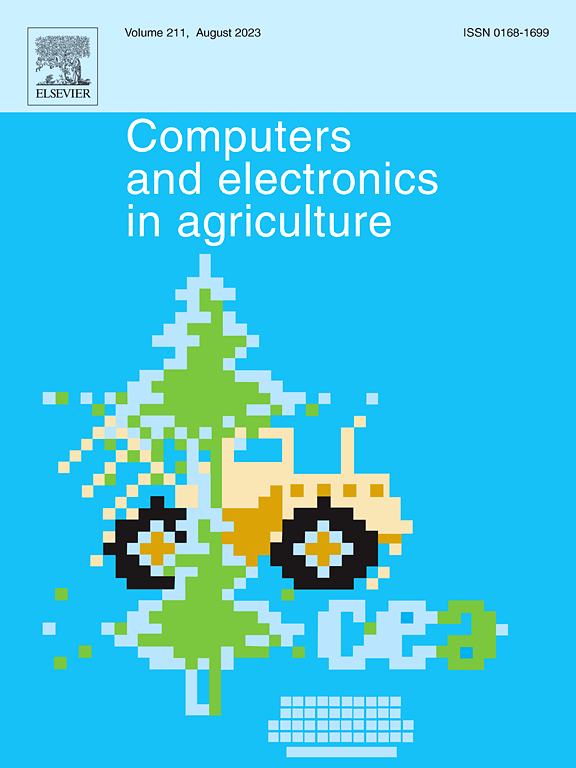利用物理信息神经网络和时间序列分解估计植物根系密度分布
IF 8.9
1区 农林科学
Q1 AGRICULTURE, MULTIDISCIPLINARY
引用次数: 0
摘要
测量植物根系密度分布对土壤水力特性、生物地球化学过程和水资源有效性具有重要意义,但目前的方法存在破坏性或人工成本问题。本文提出了一种估算植物根密度分布的新方法。首先,利用物理信息神经网络(pinn)将多个深度的土壤基质势(SMP)转化为土壤体积含水量(VSWC)。随后,利用时间序列分解方法提取植物根系吸水引起的VSWC的周期性波动。随后,对不同深度的周期波动峰进行平均和归一化处理。在数据中加入噪声以检验方法的鲁棒性。信噪比(SNR)为无噪声、50db、40db、30db、20db、10db时,估计结果的相关系数分别为0.94、0.92、0.95、0.66、0.06、0.16。采用信噪比小于30db的VSWC和SMP分别估算植物根系分布。基于SMP的结果相关系数分别为- 0.18、- 0.78和- 0.16,基于VSWC的结果相关系数分别为0.91、0.78和0.83。VSWC传感器在30 dB信噪比下保持稳健性能(r = 0.91-0.78),而SMP传感器需要≥40 dB信噪比才能避免误差。最后,利用竹(Monsteradeliciosa Liebm)土壤柱进行的实验室验证表明,估算的根密度与重量测量的根密度非常吻合(r = 0.89)。该方法在使用VSWC时具有最佳的鲁棒性,并且在SMP信噪比超过30 dB时也可以使用。本文章由计算机程序翻译,如有差异,请以英文原文为准。
Estimating plant root density distribution using physics-informed neural networks and time series decomposition
Measuring plant root density distribution is important for soil hydraulic properties, biogeochemical processes, and water resource availability, yet current methods face destructive or labor-cost problem. In this paper, we proposed a novel method to estimate plant root density distribution. First, physics-informed neural networks (PINNs) was employed to convert soil matric potential (SMP) at multiple depths into volumetric soil water content (VSWC). Subsequently, a time series decomposition method is utilized to extract periodic fluctuations in VSWC due to water uptake by the plant root system. Subsequently, the peaks of the periodic fluctuations were averaged and normalized across different depths. Noise was added to the data to test the robustness of the method. The correlation coefficients of the estimated results were 0.94, 0.92, 0.95, 0.66, 0.06, 0.16 when the signal-to-noise ratios (SNR) were no noise, 50db, 40db, 30db, 20db, 10db. VSWC and SMP with SNR less than 30db were used to estimate plant root distribution separately. The correlation coefficients of the results based on SMP were −0.18, −0.78, and −0.16, respectively, and the results based on VSWC were 0.91, 0.78, and 0.83, respectively. VSWC sensors maintained robust performance (r = 0.91–0.78) down to 30 dB SNR, while SMP sensors required ≥ 40 dB SNR to avoid error. Finally, laboratory validation using instrumented soil columns with bamboo (Monsteradeliciosa Liebm) demonstrated strong agreement between estimated and gravimetrically-measured root densities (r = 0.89). The method demonstrates optimal robustness when VSWC is employed and can also be utilized when the SNR of the SMP exceeds 30 dB.
求助全文
通过发布文献求助,成功后即可免费获取论文全文。
去求助
来源期刊

Computers and Electronics in Agriculture
工程技术-计算机:跨学科应用
CiteScore
15.30
自引率
14.50%
发文量
800
审稿时长
62 days
期刊介绍:
Computers and Electronics in Agriculture provides international coverage of advancements in computer hardware, software, electronic instrumentation, and control systems applied to agricultural challenges. Encompassing agronomy, horticulture, forestry, aquaculture, and animal farming, the journal publishes original papers, reviews, and applications notes. It explores the use of computers and electronics in plant or animal agricultural production, covering topics like agricultural soils, water, pests, controlled environments, and waste. The scope extends to on-farm post-harvest operations and relevant technologies, including artificial intelligence, sensors, machine vision, robotics, networking, and simulation modeling. Its companion journal, Smart Agricultural Technology, continues the focus on smart applications in production agriculture.
 求助内容:
求助内容: 应助结果提醒方式:
应助结果提醒方式:


